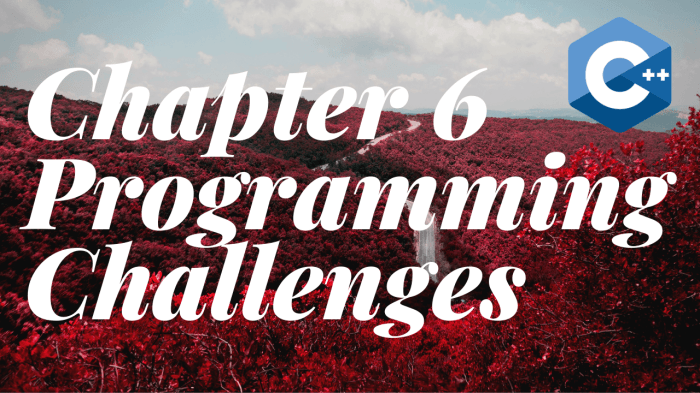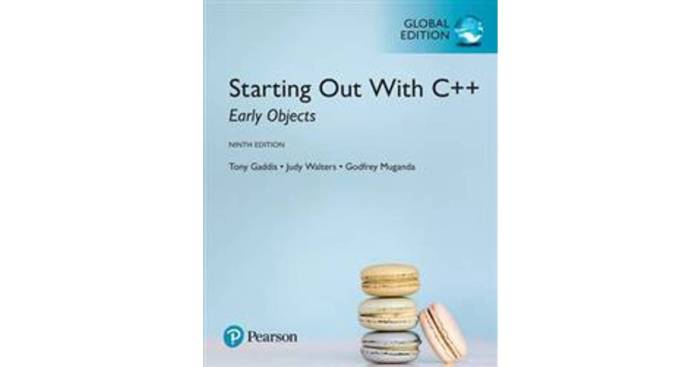Starting out with c++: early objects 10th edition pdf – Embark on a comprehensive learning journey with ‘Starting Out with C++: Early Objects, 10th Edition’ PDF, the definitive guide to mastering the fundamentals of C++ programming. This comprehensive resource caters to beginners and experienced programmers alike, providing a solid foundation in the core concepts, object-oriented programming principles, and advanced C++ features.
Delving into the intricacies of C++, this book elucidates the fundamental syntax, data types, operators, and control flow mechanisms. It seamlessly transitions into object-oriented programming, exploring the concepts of classes, objects, inheritance, and polymorphism. The exploration extends to essential data structures and algorithms, empowering readers with the knowledge to manipulate and organize data efficiently.
1. Introduction to C++ Early Objects 10th Edition PDF
The C++ Early Objects 10th Edition PDF book is a comprehensive guide to the C++ programming language. It is designed for beginners who want to learn the fundamentals of C++ and for experienced programmers who want to refresh their knowledge or learn about new features.
The book covers a wide range of topics, including the basic syntax and structure of the C++ programming language, fundamental concepts such as variables, data types, operators, and control flow, object-oriented programming with C++, data structures and algorithms in C++, input/output and file handling in C++, advanced C++ features such as templates, exception handling, and multithreading, and case studies and applications.
Target Audience and Prerequisites
The book is intended for beginners who have no prior programming experience. However, it is also suitable for experienced programmers who want to learn about C++ or refresh their knowledge.
The book assumes that the reader has a basic understanding of computer science concepts such as variables, data types, and control flow.
Structure and Organization
The book is divided into eight chapters. The first chapter provides an introduction to C++ and the second chapter covers the basic syntax and structure of the C++ programming language.
The third chapter discusses object-oriented programming with C++. The fourth chapter covers data structures and algorithms in C++. The fifth chapter discusses input/output and file handling in C++.
The sixth chapter discusses advanced C++ features such as templates, exception handling, and multithreading. The seventh chapter provides case studies and applications.
The eighth chapter provides resources and further reading.
2. Core Concepts of C++
The core concepts of C++ include the basic syntax and structure of the language, fundamental concepts such as variables, data types, operators, and control flow, and object-oriented programming.
Basic Syntax and Structure
C++ is a free-form language, which means that the programmer is not required to follow a specific syntax. However, there are some basic rules that must be followed in order to write valid C++ code.
A C++ program consists of one or more functions. A function is a block of code that performs a specific task. The main() function is the entry point of a C++ program.
Fundamental Concepts
Variables are used to store data in C++. Variables are declared using the type , followed by the variable name. For example, the following code declares a variable named x of type int:
int x;
Data types specify the type of data that can be stored in a variable. C++ has a variety of data types, including int, float, double, and char.
Operators are used to perform operations on data. C++ has a variety of operators, including arithmetic operators, relational operators, and logical operators.
Control flow statements are used to control the flow of execution in a C++ program. Control flow statements include if statements, for loops, and while loops.
Object-Oriented Programming
Object-oriented programming is a programming paradigm that emphasizes the use of objects and classes. Objects are instances of classes, and classes define the data and behavior of objects.
Object-oriented programming is a powerful tool that can be used to create complex and maintainable programs.
3. Object-Oriented Programming with C++

Object-oriented programming (OOP) is a programming paradigm that emphasizes the use of objects and classes. Objects are instances of classes, and classes define the data and behavior of objects.
OOP is a powerful tool that can be used to create complex and maintainable programs. OOP concepts include encapsulation, inheritance, and polymorphism.
Encapsulation, Starting out with c++: early objects 10th edition pdf
Encapsulation is the bundling of data and methods into a single unit. Encapsulation helps to protect data from being accessed or modified by unauthorized code.
Inheritance
Inheritance is the ability for a class to inherit the properties and methods of another class. Inheritance helps to promote code reuse and reduce the amount of code that needs to be written.
Polymorphism
Polymorphism is the ability for a class to behave differently depending on the context in which it is used. Polymorphism helps to make code more flexible and maintainable.
4. Data Structures and Algorithms in C++: Starting Out With C++: Early Objects 10th Edition Pdf

Data structures are used to organize and store data in a computer program. Algorithms are used to process data in a specific way.
C++ provides a variety of data structures, including arrays, linked lists, stacks, and queues. C++ also provides a variety of algorithms, including sorting algorithms, searching algorithms, and graph algorithms.
Data structures and algorithms are essential for writing efficient and effective C++ programs.
Arrays
Arrays are a simple data structure that can be used to store a collection of elements of the same type. Arrays are indexed, which means that each element can be accessed using an index.
Linked Lists
Linked lists are a data structure that can be used to store a collection of elements of the same type. Linked lists are not indexed, which means that each element is accessed by following a pointer to the next element.
Stacks
Stacks are a data structure that can be used to store a collection of elements of the same type. Stacks are LIFO (last-in, first-out), which means that the last element added to the stack is the first element removed.
Queues
Queues are a data structure that can be used to store a collection of elements of the same type. Queues are FIFO (first-in, first-out), which means that the first element added to the queue is the first element removed.
Sorting Algorithms
Sorting algorithms are used to sort a collection of elements into a specific order. C++ provides a variety of sorting algorithms, including the bubble sort, the selection sort, and the quicksort.
Searching Algorithms
Searching algorithms are used to find a specific element in a collection of elements. C++ provides a variety of searching algorithms, including the linear search and the binary search.
Graph Algorithms
Graph algorithms are used to process graphs. Graphs are data structures that can be used to represent relationships between objects.
Popular Questions
What are the prerequisites for using this book?
Basic computer literacy and a willingness to learn C++ programming are the primary prerequisites.
Is this book suitable for both beginners and experienced programmers?
Yes, ‘Starting Out with C++: Early Objects, 10th Edition’ PDF is designed to cater to the needs of both beginners and experienced programmers.
What are the key features covered in this book?
The book covers a wide range of topics, including C++ syntax, data types, operators, control flow, object-oriented programming, data structures, algorithms, input/output operations, file handling, advanced C++ features, and practical applications.